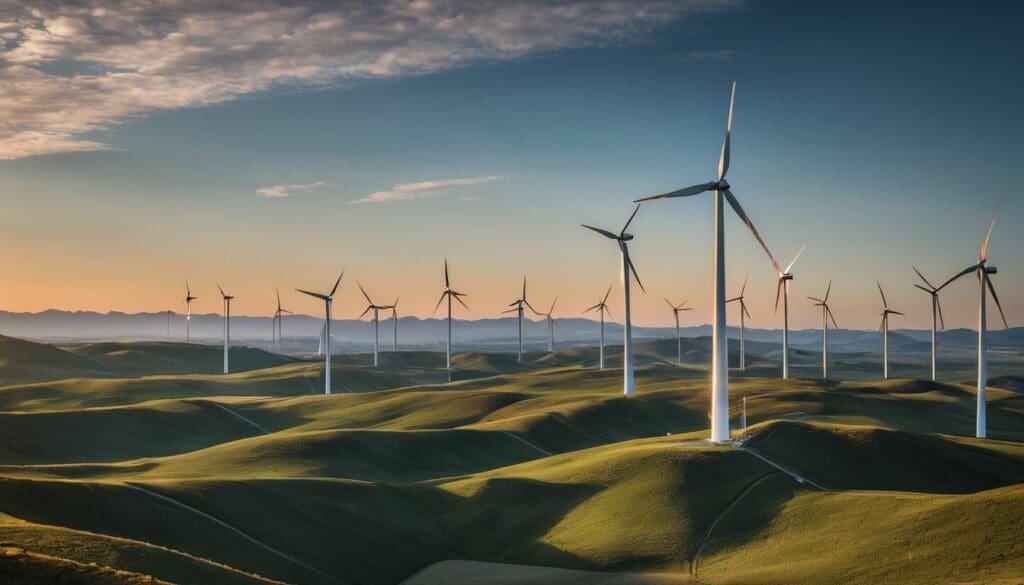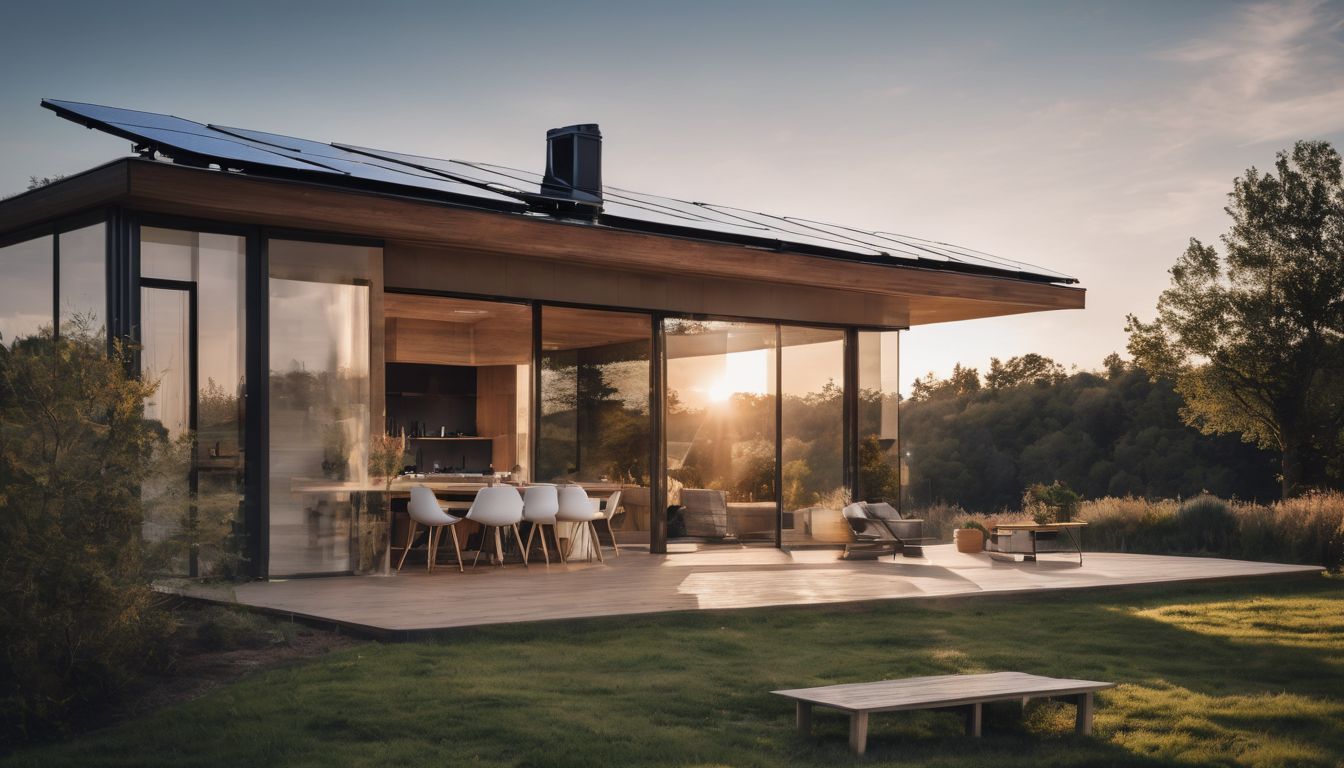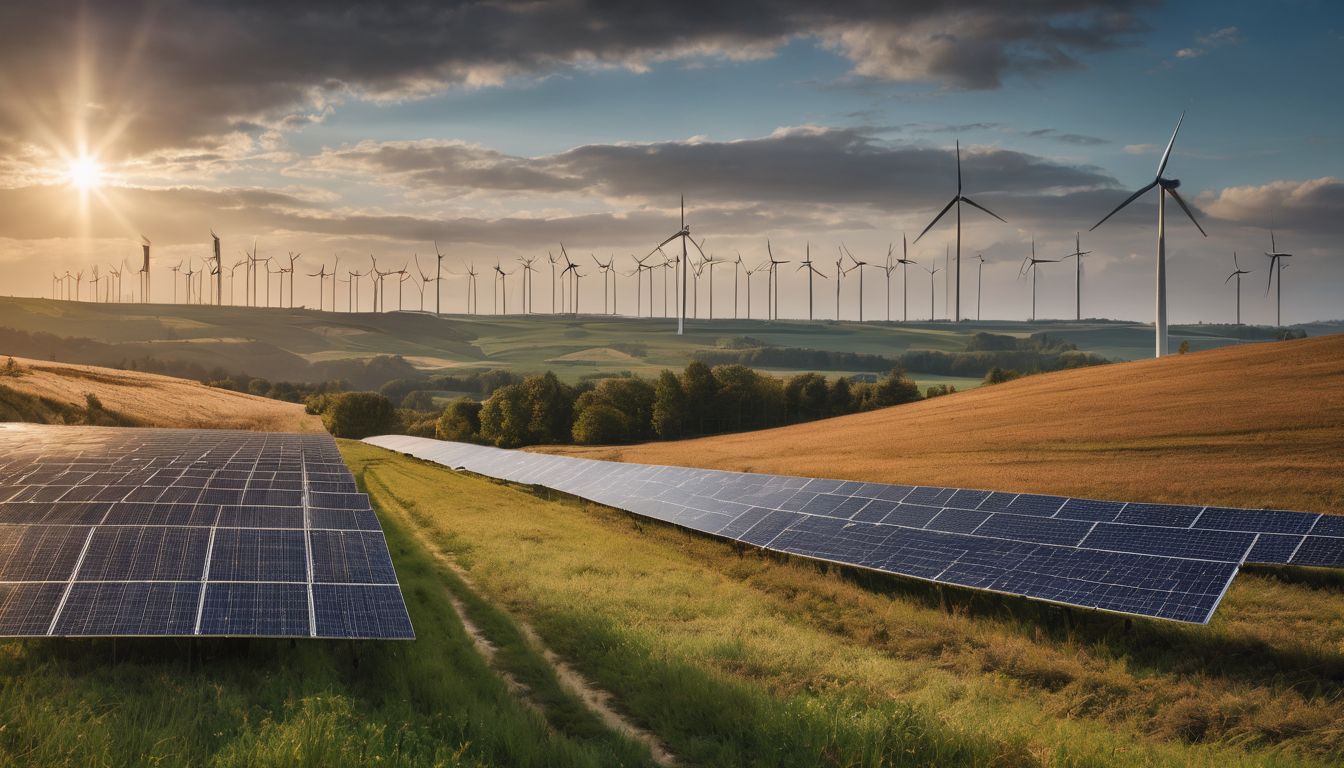Transitioning to sustainable energy is a challenge we all face as global citizens seeking a greener future. By 2030, renewable sources could power 50% of the world’s electricity, drastically reducing carbon emissions worldwide.
This article will guide you through the essentials of crafting an effective sustainable energy plan that caters to conservation and environmental well-being. Discover simple steps towards a brighter, cleaner tomorrow.
Key Takeaways
- Sustainable energy comes from sources like solar, wind, hydroelectricity, and geothermal that are replenished within a human lifetime and have minimal impact on the environment.
- A sustainable energy action plan lays out steps to reduce emissions and increase renewable energy use, involving an assessment of current usage, goal setting, stakeholder engagement, resource allocation and progress tracking with tools such as life cycle analysis and carbon footprint calculators.
- Renewable energy sources offer benefits including long – term savings on bills and lower greenhouse gas emissions but may have higher upfront costs; incentives like tax credits can help offset these initial expenses.
- Strategies for achieving net zero energy in buildings focus on reducing operational carbon emissions through improved efficiency alongside minimising embodied carbon in construction materials by using low-carbon alternatives.
- Incorporating biophilic design elements into building environments connects occupants with nature whilst enhancing well-being and supporting broader sustainability goals.
Understanding Sustainable Energy
Sustainable energy is the use of energy in a way that meets our current needs without compromising the ability of future generations to meet their own needs. It’s essential for reducing carbon emissions and protecting the environment.
Definition of sustainable energy
Sustainable energy comes from sources that don’t run out and can be replenished within a human lifetime. It causes little to no harm to the environment, slashing carbon emissions and reducing our carbon footprint.
Think solar power, wind energy, hydroelectricity, and geothermal – these are all clean energy systems harnessing the Earth’s natural processes. These renewable resources play a crucial role in sustainable development by providing reliable power without depleting our planet.
Transitioning to green energy is key for fighting climate change. By switching from fossil fuels to renewable alternatives, we protect biodiversity and promote environmental conservation while meeting our growing energy needs.
Energy efficiency measures also form part of this approach; using less and making what we do use go further contributes significantly towards sustainability goals. Investing in such renewable portfolio standards leads us towards net zero energy ambitions where our consumption aligns harmoniously with nature’s offerings.
Importance of sustainable energy
Sustainable energy is crucial for reducing carbon emissions and mitigating the impact of climate change. By investing in sustainable design and renewable energy systems, individuals and organisations can actively contribute to energy conservation, ultimately supporting climate action.
Not only does this help in reducing the reliance on non-renewable resources, but it also paves the way for a cleaner environment and lower carbon taxes.
Moreover, embracing sustainable energy solutions aligns with the commitment to alternative energy sources, fostering a future where net zero energy consumption becomes achievable. As environmentally conscious individuals seek to make a positive impact through their actions, understanding the significance of sustainable energy is paramount in driving meaningful change towards a more environmentally friendly world.
Steps to Implement a Sustainable Energy Action Plan
Creating a Sustainable Energy Action Plan involves identifying energy-saving opportunities, setting goals, and outlining specific actions to achieve those goals. WatchWire can assist your organisation in developing a customised roadmap for implementing sustainable energy practices.
What is a sustainable energy action plan?
A sustainable energy action plan outlines specific steps for reducing carbon emissions and promoting energy generation from renewable sources. It serves as a strategic roadmap to guide organisations in achieving their environmental goals.
By creating a comprehensive plan, companies can effectively manage energy consumption, implement renewable technologies, and reduce their overall carbon footprint. This proactive approach not only supports sustainability but also contributes to long-term conservation efforts.
Creating a sustainable energy action plan involves identifying areas where energy efficiency improvements can be made, setting realistic targets for emission reduction, implementing renewable technologies, and fostering an organisational culture that values sustainability.
How to create a roadmap for your organisation
To create a roadmap for your organisation to implement a sustainable energy action plan, follow these steps:
- Assess your current energy usage and identify areas for improvement. This may involve conducting an energy audit or using software to track and analyse energy consumption data.
- Set clear goals and targets for reducing carbon emissions and increasing the use of renewable energy sources. These should be specific, measurable, achievable, relevant, and time-bound (SMART).
- Engage key stakeholders within your organisation to gain support and buy-in for the sustainable energy plan. This could include forming a cross-functional team or establishing an energy management committee.
- Develop an action plan that outlines the steps required to achieve your sustainability goals. This may involve prioritising energy efficiency measures, investing in renewable energy technologies, or exploring opportunities for energy conservation.
- Allocate resources and establish a budget for implementing the sustainable energy action plan. Consider seeking external funding or incentives to support the transition to sustainable energy practices.
- Monitor and track progress towards your sustainability targets using key performance indicators (KPIs) related to energy efficiency, carbon emissions reduction, and renewable energy adoption.
- Continuously review and update the roadmap based on new technologies, regulatory changes, or evolving business priorities to ensure ongoing success in meeting your sustainable energy objectives.
WatchWire’s role in helping with sustainable energy plans
To support sustainable energy plans, WatchWire offers tailored solutions that optimise energy usage and promote renewable resources. Through advanced monitoring and data analysis, WatchWire identifies opportunities to reduce carbon footprint and increase efficiency.
By integrating smart technology and predictive analytics, organisations can make informed decisions to implement sustainable energy practices.
WatchWire empowers environmentally conscious individuals and organisations by providing real-time insights into energy consumption and offering customised strategies for adopting renewable sources.
Basics of Renewable Energy
Renewable energy sources, such as solar and wind power, offer sustainable alternatives to traditional fossil fuels. Understanding the costs, benefits, and tools for evaluating renewable energy options is key to building a sustainable energy plan.
Types of renewable energy
Renewable energy sources are crucial in a sustainable energy plan. Here are the main types:
- Solar Power: Harnessing energy from the sun through solar panels.
- Wind Power: Utilising wind turbines to generate electricity.
- Hydroelectric Power: Generating electricity from flowing or falling water.
- Biomass Energy: Using organic materials like wood, crops, and waste to produce heat or electricity.
- Geothermal Energy: Tapping into the Earth’s heat for power generation.
Costs and benefits of renewable energy
Evaluating the costs and benefits of renewable energy is crucial for developing a sustainable energy plan. Below is a summary presented in a table format that outlines the key financial and environmental aspects to consider.
| Aspect | Costs | Benefits |
|---|---|---|
| Initial Investment | Higher upfront cost compared to conventional energy sources. | Long-term savings on energy bills. |
| Maintenance | Some renewable energy systems require periodic maintenance. | Generally lower maintenance costs over time due to fewer moving parts. |
| Energy Prices | Exposure to fluctuating energy market prices is reduced. | Stable energy costs after initial investment. |
| Environmental Impact | Some environmental cost during manufacturing and installation. | Significantly lower greenhouse gas emissions during operation. |
| Energy Independence | Dependency on imported fuels decreases. | Enhanced energy security through localised energy production. |
| Job Creation | Transitioning to renewable energy may disrupt current jobs in traditional energy sectors. | Creation of new jobs in the renewable energy sector. |
| Technological Advancement | Adoption of new technologies can be slow due to familiarity with existing systems. | Innovation in technology leads to more efficient and cheaper renewable energy solutions in the future. |
| Health and Safety | Investment in safety training for new technologies may be required. | Improved public health due to reduced air and water pollution. |
| Government Incentives | Varying levels of government support and incentives can impact the financial viability. | Access to grants, tax credits, and rebates to offset initial costs. |
By understanding these costs and benefits, stakeholders can make informed decisions on transitioning to renewable energy sources, aligning with conservation efforts and environmental sustainability goals.
Tools to evaluate renewable energy options
Evaluate various renewable energy options using the following tools:
- Life Cycle Analysis: This tool assesses the environmental impact of renewable energy options throughout their entire life cycle, from production to disposal.
- Cost-Benefit Analysis: Compare the initial costs and long-term savings of different renewable energy technologies to determine the most financially viable option for your organisation.
- Carbon Footprint Calculators: Use these tools to measure the amount of greenhouse gas emissions produced by each renewable energy option, helping you choose the most climate-friendly solution.
- Energy Modelling Software: These programs simulate how different renewable energy systems would perform in your specific environment, allowing you to make informed decisions based on real-world data.
- Environmental Impact Assessment Tools: Assess the potential environmental effects of implementing various renewable energy technologies on local ecosystems and communities.
Resources for learning more about renewable energy
Once you’ve grasped the basics of renewable energy, it’s essential to continue learning and staying updated on the latest developments. Books, online courses, and webinars offer in-depth knowledge about various types of renewable energy sources such as solar, wind, and hydroelectric power.
Industry conferences and workshops are also valuable opportunities to network with experts and gain practical insights into implementing renewable energy solutions. Additionally, government websites and academic databases provide access to reports, studies, and research papers that can enhance your understanding of the economic and environmental aspects of renewable energy.
For those looking for a more interactive approach to learning about renewable energy, joining community groups or associations focused on sustainable practices provides a platform for sharing experiences and accessing valuable resources.
Key Strategies for Net Zero Energy
Achieving net zero energy requires a holistic approach that includes reducing energy load, decarbonising building systems, minimising embodied carbon, and incorporating biophilia. Starting with an understanding of climate and integrating these key strategies will help organisations move towards achieving their sustainable energy goals.
Starting with climate
Climate plays a pivotal role in shaping sustainable energy plans. By understanding the local climate, individuals and organisations can optimise renewable energy sources like solar or wind power.
Adapting to seasonal variations and weather patterns enables better integration of sustainable energy solutions, helping to reduce overall energy consumption and environmental impact.
Considering the climatic conditions also allows for smarter building design that harnesses natural resources such as sunlight and airflow, reducing the need for excessive artificial heating, cooling, and lighting.
Reducing energy load
To reduce energy load, start by conducting an energy audit to identify areas of high consumption. Implementing energy-efficient lighting and appliances can also significantly decrease the amount of power needed.
Proper insulation and sealing can prevent heat loss in buildings, further reducing the demand for heating and cooling. Additionally, integrating smart building technologies such as automated lighting and HVAC systems helps optimise energy usage based on real-time needs.
By adopting these practices, individuals and organisations can lower their environmental impact while saving on energy costs. It’s important to monitor ongoing energy use to identify any inefficiencies and make continuous improvements towards a sustainable future.
Decarbonising building systems
Decarbonising building systems involves reducing carbon emissions from energy use in buildings. This can be achieved through measures such as improving energy efficiency, transitioning to low-carbon heating and cooling systems, and using renewable energy sources.
By making these changes, buildings can play a crucial role in decreasing overall carbon emissions and moving towards sustainable energy usage.
To decarbonise building systems effectively, it’s important to address both operational carbon emissions from day-to-day activities within the building as well as embodied carbon within the materials used for construction.
Minimising embodied carbon
Minimising embodied carbon involves reducing the carbon footprint of materials used in construction. Choosing low-carbon materials, like sustainably sourced timber or recycled steel, decreases the overall environmental impact of a building project.
By embracing innovative construction techniques and implementing efficient designs, such as modular construction or using local materials, it’s possible to significantly reduce embodied carbon.
Incorporating Life Cycle Assessment (LCA) can also help in evaluating and selecting materials with lower embodied carbon. This approach considers the environmental impact of a material from extraction to disposal.
Incorporating biophilia
Biophilic design integrates natural elements into built environments, fostering a connection with nature and enhancing overall well-being. Incorporating biophilia in your sustainable energy plan can include integrating natural light, using organic materials, and incorporating greenery within buildings.
By embracing biophilic principles, organisations can create spaces that promote productivity, reduce stress, and support environmental conservation efforts.
Engaging with biophilia contributes to a healthier indoor environment while supporting sustainability goals. Embracing nature in our built environment is an essential component of a comprehensive sustainable energy strategy.
Moving beyond energy efficiency measures, the inclusion of biophilic elements offers tangible benefits for both individuals and the planet.
Conclusion
In conclusion, understanding sustainable energy is crucial for building a greener future. Implementing a sustainable energy action plan involves creating a roadmap and utilising tools to evaluate renewable energy options.
Key strategies for achieving net zero energy include reducing energy load and incorporating biophilia into building systems. By taking these steps, we can make significant strides towards a more sustainable and environmentally friendly future.
FAQs
1. What is a sustainable energy plan?
A sustainable energy plan is a strategy for utilising renewable resources to meet energy needs without harming the environment.
2. Why should we build a sustainable energy plan?
Building a sustainable energy plan helps reduce our carbon footprint, conserve resources, and support long-term ecological balance.
3. What are the key steps in creating this type of energy plan?
The basics involve conducting an energy audit, setting clear goals, choosing appropriate renewable sources, and outlining measures for conservation and efficiency.
4. Who benefits from following a sustainable energy plan?
Everyone benefits; from individuals saving on costs to societies gaining cleaner environments and future generations inheriting a healthier planet.





